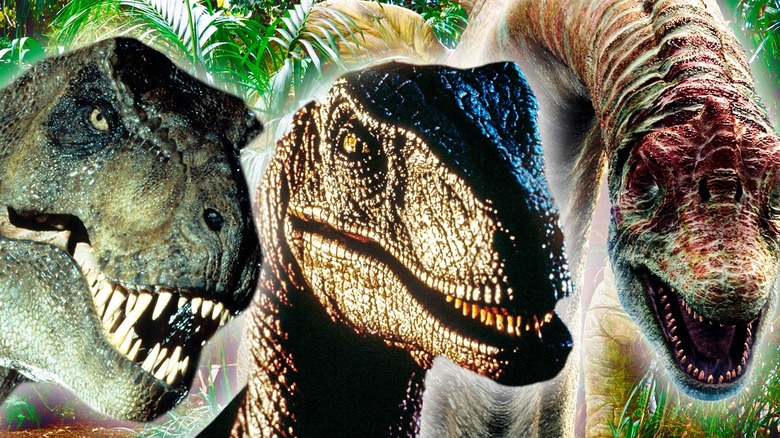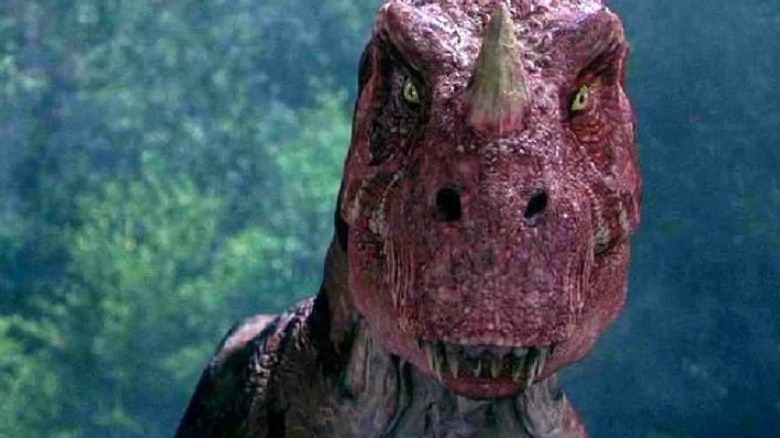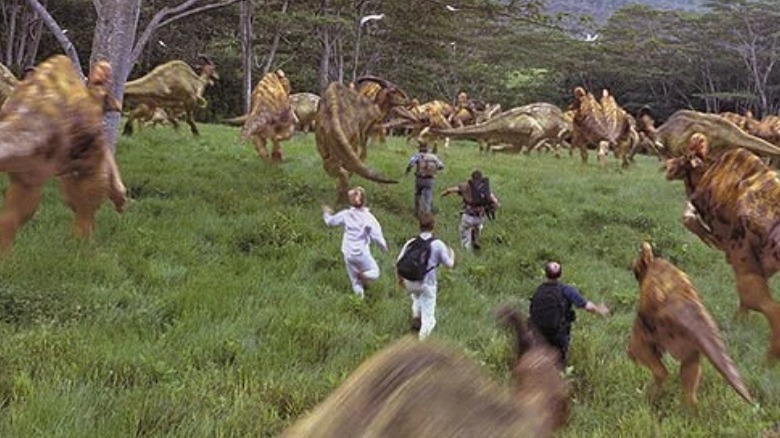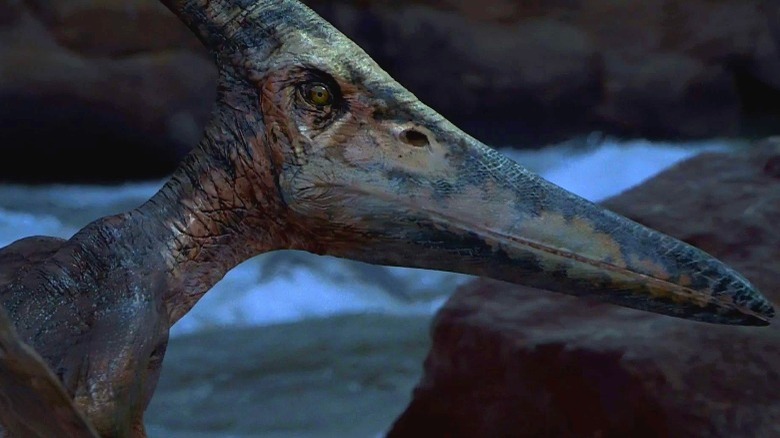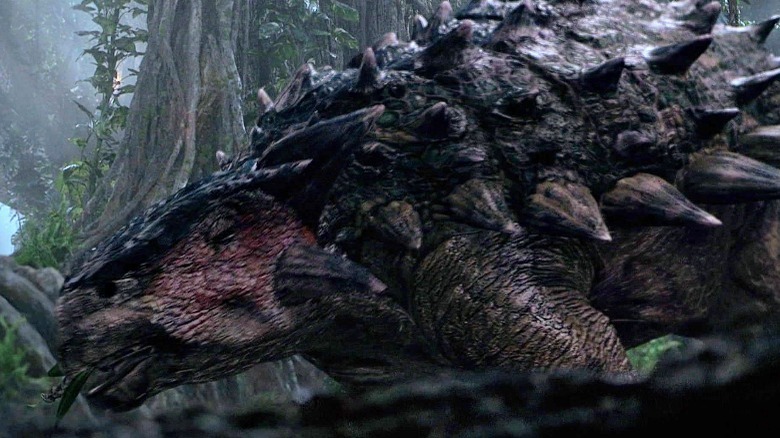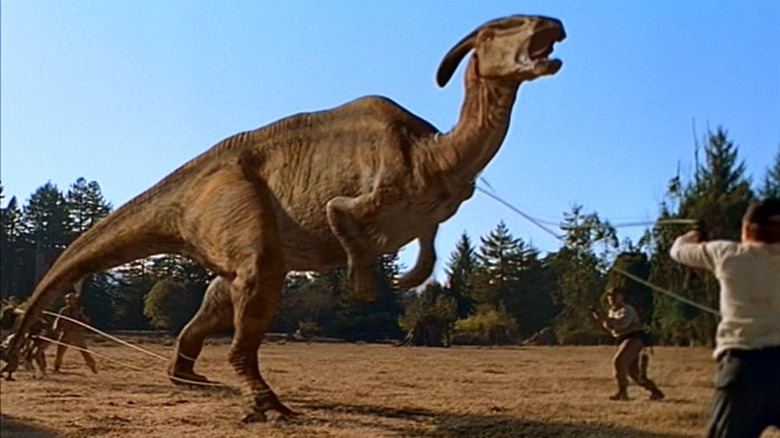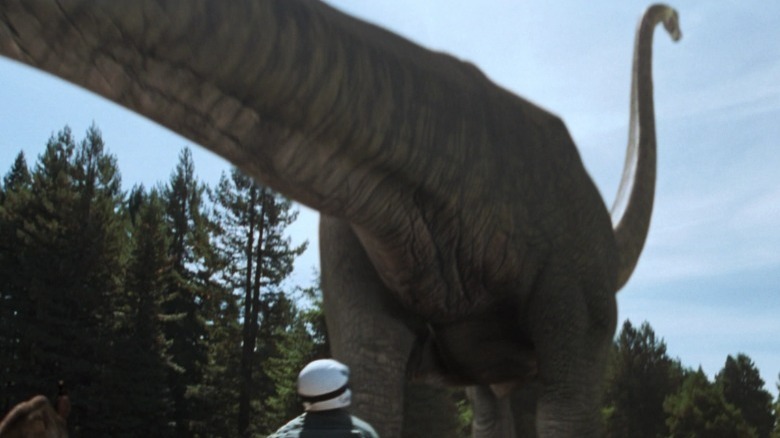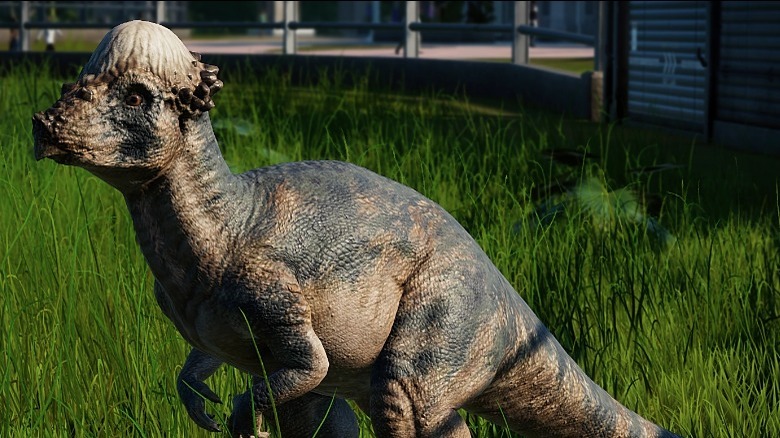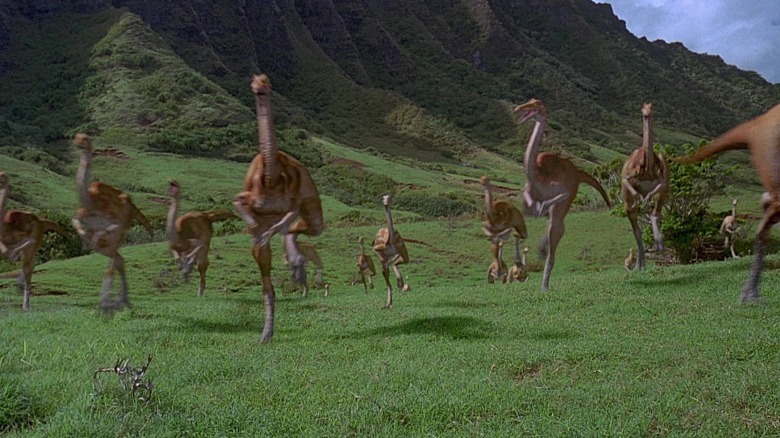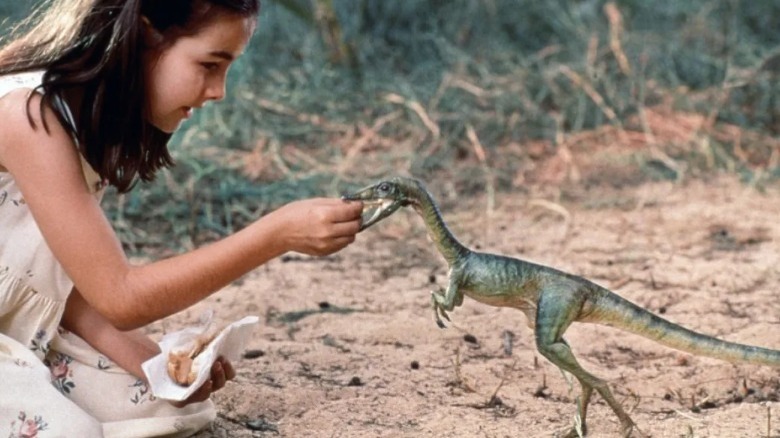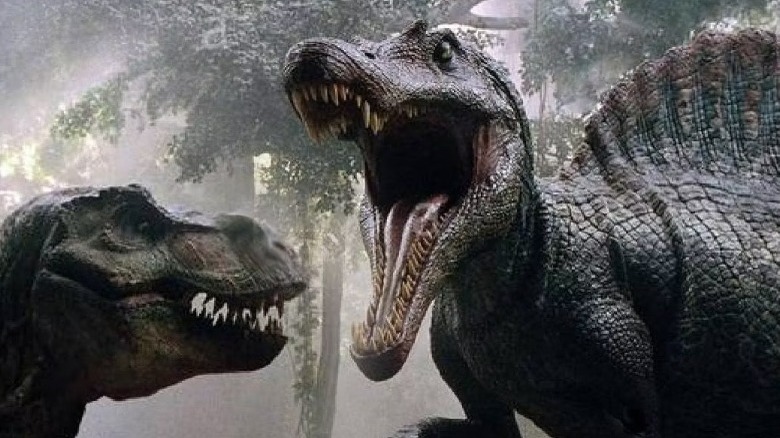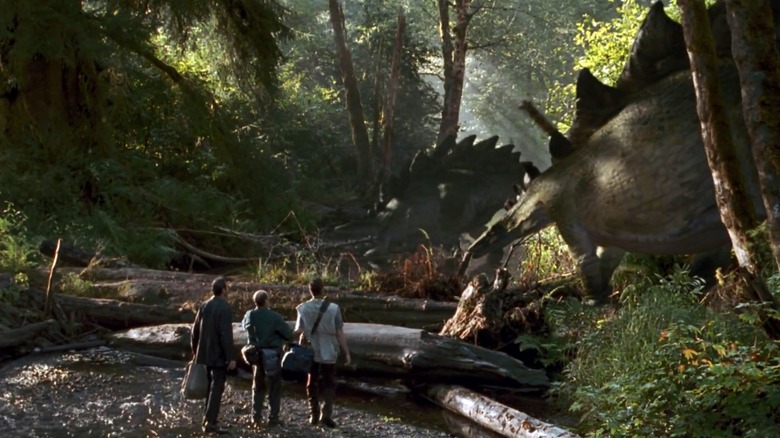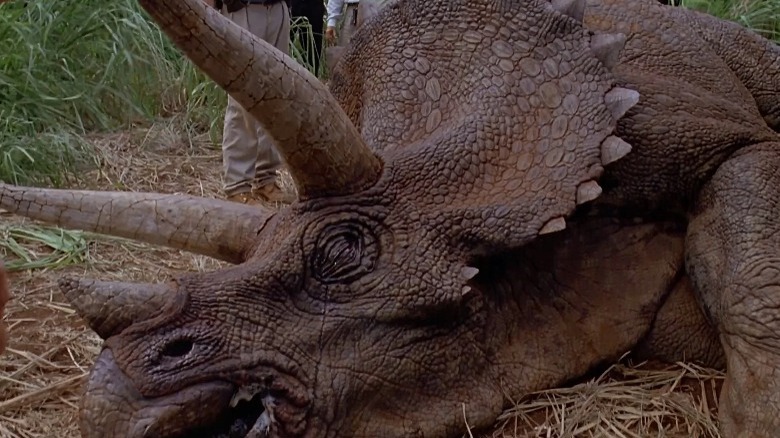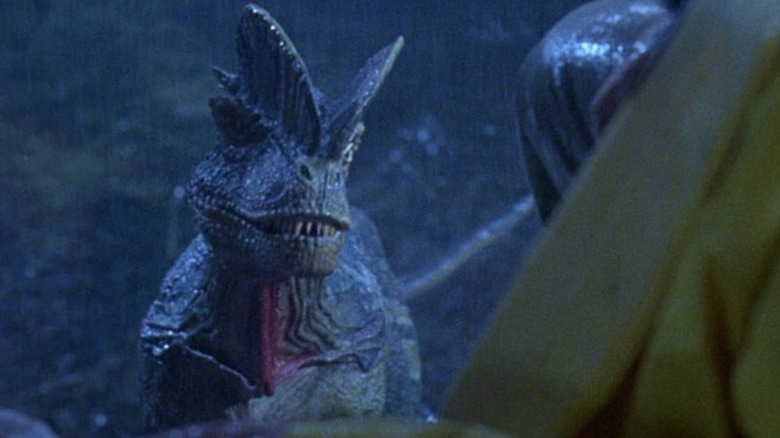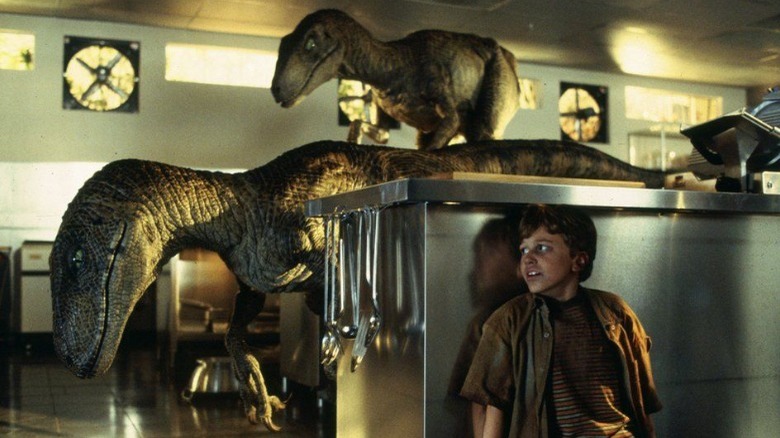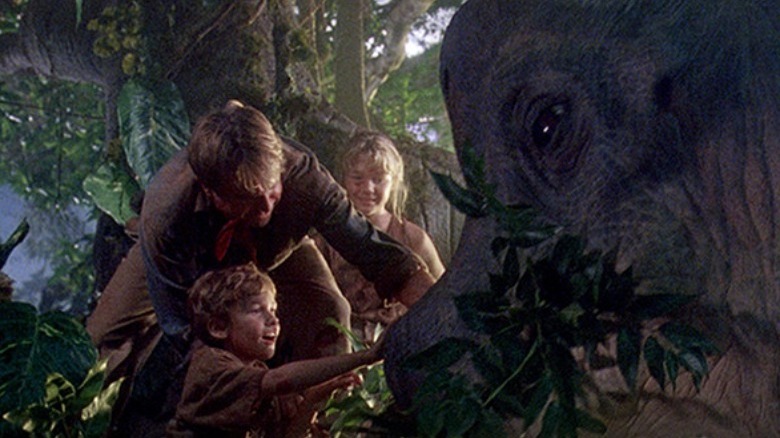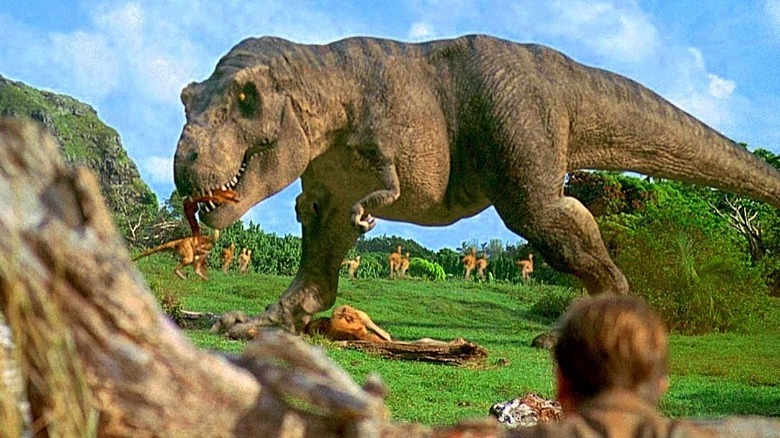Every Dinosaur In The Original Jurassic Park Trilogy Explained
Although the franchise found new life in the 21st century with the "Jurassic World" movies, '90s kids will always have a special nostalgia for the original "Jurassic Park" trilogy. The first movie, directed by Steven Spielberg and adapted from the Michael Crichton novel of the same name, became a pop culture phenomenon immediately upon its release in the summer of 1993.
That first movie, a thrilling adventure in a dinosaur theme park where everything goes wrong, made history with its thrilling action sequences and visual effects that combined animatronics with groundbreaking CGI. While there were only six different species of dinosaurs seen in the original "Jurassic Park," the two subsequent films introduced viewers to even more extinct creatures on the island of Isla Sorna, aka "Site B."
While the films instilled a generation with a fascination for dinosaurs, the actual science of "Jurassic Park" was never the priority. They don't actually take the time to tell you a whole lot about the prehistoric creatures, outside of the various ways that they can kill people. So if you ever wanted to know more about the creatures showcased in the original "Jurassic Park" trilogy, we're here to help, and we've spared no expense.
Ceratosaurus
The Ceratosaurus is a predator that looks somewhat similar to an Allosaurus or a Tyrannosaurus rex, although it has some defining features that mark it as its own distinctive species. A single Ceratosaurus is seen in "Jurassic Park III" when Dr. Alan Grant and members of the Kirby family are searching for a satellite phone to call for help. The dinosaur approaches the characters but rather than attacking them, it gives them a quick sniff before moving along. The smell of the Spinosaurus dung that they had just been digging through seemingly scares away the smaller predator.
Ceratosaurus was a carnivorous dinosaur that lived around 150 million years ago. Fossils of the six-meter-long animal, which likely weighed around 1000kg, have been found in Portugal and the United States. Part of the same large theropod family as the likes of Tyrannosaurus rex, it was much smaller than its more famous cousin and also had unique horn-like protrusions along its head and back. The fact that it didn't try to eat any of the humans it came across might make some sense, as scientists believe it likely hunted very small dinosaurs and aquatic creatures such as fish.
Corythosaurus
Corythosaurus is not a dinosaur that many people will remember from the original "Jurassic Park" trilogy, especially because it only makes an appearance in the third film. One of the many large ornithopods roaming Isla Sorna, a herd of them can be seen outside of the "Site B" InGen Compound. While trying to escape from a pursuing group of Velociraptors, Dr. Grant and the others trapped on the island inadvertently run into the herd, causing a stampede that forces the characters to separate to avoid being crushed.
As a herbivore, Corythosaurus would likely have not posed much of a threat, but their large size would have made them a danger for anyone who encountered one. The dinosaur lived between 76 and 74 million years ago, and could have reached lengths of up to 10 meters in total. Primarily living in areas that are now the United States and Canada, Corythosaurus stood on two feet, with a duck-billed face and a helmet-like hard crest on the top of its head.
Pteranodon
Though they're not technically dinosaurs, Pteranodon can be seen briefly flying overhead in large groups in "The Lost World: Jurassic Park" when Ian Malcolm and his colleagues become trapped on the island of Isla Sorna. By the time of "Jurassic Park III," the winged beasts have seemingly grown in number and play a more active role in events. Forced to travel through the aviary, Dr. Alan Grant and the surviving members of the Kirby expedition are attacked by several adult Pteranodons, including one that takes the young Eric away to a nest. There a group of juvenile Pteranodon attempt to devour Eric before he's rescued at the last minute.
Pteranodons are part of the pterosaur group, which were bird-like reptiles that could fly thanks to their large wings. There were more than 130 different species of these flying creatures, but the Pteranodon was one of the largest. They lived during the late Cretaceous period and would have had a wingspan of around six meters. Research suggests they would have spent most of their lives in the air or on water, rarely coming into contact with land.
Ankylosaurus
Although most dinosaurs look very different from any modern animals alive today, Ankylosaurus stands out as one of the most unique looks. They are also one of the few dinosaurs in the original "Jurassic Park" trilogy that have very little impact on the story. In fact, they don't really make a significant appearance until "Jurassic World." During two separate scenes in "Jurassic Park III," though, several Ankylosaurus can be seen moving through a forested area and grazing on grass near a river.
A type of armored dinosaur, Ankylosaurus resembled a walking tank. It had tough armor covering the top of its entire body and a club-like tail that it could use to defend itself. This made it difficult to prey on and helped ensure its survival against threats like Tyrannosaurus rex, which inhabited the same regions. As one of the last dinosaurs on the planet before the Cretaceous–Paleogene extinction event, Ankylosaurus could grow up to 8 meters long and weigh more than 4000kg.
Parasaurolophus
In many respects, the Parasaurolophus is very similar to the Corythosaurus, with its duck bill and distinctive head shape. They can be seen in all three of the "Jurassic Park" movies, and are actually one of the first dinosaurs that Dr. Alan Grant, Dr. Ellie Sattler, and Dr. Ian Malcolm see when they arrive on Isla Nublar. They can be spotted in that memorable with several other species in the Brachiosaurus enclosure, and they later appear as part of larger herds in both "The Lost World: Jurassic Park" and "Jurassic Park III." Most notably, they're involved in two stampede scenes when InGen Hunters attempt to capture one of the wild Parasaurolophus, and when Dr. Grant and the Kirby family flee from Velociraptors outside the InGen compound.
Parasaurolophus lived between 98 and 65 million years ago. It had a large crest on the top of its head that could extend to almost two meters, and would likely have grazed on grass like other Hadrosauridae dinosaurs. A fully grown adult could have reached a length of 10 meters and stood almost 5 meters tall, weighing an impressive 4000kg. As shown in the films, it would have been able to sprint away at fast speeds on its two hind legs, although it would probably use all four much of the time.
Mamenchisaurus
Like many other dinosaurs from the first three films in the series, Mamenchisaurus only appears for a few moments and does little to impact the adventure. Only two of the incredibly large creatures are depicted in the trilogy, with the pair showing up in "The Lost World: Jurassic Park" when the InGen hunters are trying to capture a variety of animals as part of Peter Ludlow's plan to open a park in San Diego. They emerge from the forest, astonishing the human invaders with their enormous size as a motorcycle is driven underneath one of their bodies.
Mamenchisaurus might easily be confused with other sauropods such as Brachiosaurus, as they share features like a long tail and neck, along with a massive body. While it was not one of the largest examples of this type of dinosaur, it did have a defining feature that helped differentiate it from its close relatives: The Mamenchisaurus had the longest neck of any living creature in relation to its body). Alive in the Late Jurassic period, they could grow up to 22 meters in length and their necks would account for almost half of that total.
Pachycephalosaurus
Pachycephalosaurus, often called bone-headed dinosaurs, can be seen during the early parts of "The Lost World: Jurassic Park." A juvenile version of the creature is captured by InGen hunters during the game trail scene when multiple dinosaurs are subdued. The young Pachycephalosaurus doesn't go down without a fight, though, and injures two of the hunters when it charges towards them with its head. Later in the movie, two other Pachycephalosaurus are set free in the InGen camp and cause chaos as they rampage.
Hailing from the late Cretaceous era, Pachycephalosaurus are best known for their thick heads. Able to grow to 5 meters in length, these large dinosaurs had a skull with dense bone covering the top of their brain. For a long time, it was believed that Pachycephalosaurus used their head to bash into opponents to assert dominance in a similar manner to modern-day rams. However, modern research doesn't support this theory, with the large heads instead likely used as a form of display to attract mates.
Gallimimus
The Gallimimus first appears in "Jurassic Park" as part of a large herd of around 20 dinosaurs that are roaming freely throughout the park. The group moves at high speed and forces Tim, Lex, and Dr. Grant to seek cover so they aren't trampled. At the same time, the now-free Tyrannosaurus rex ambushes the smaller dinosaurs and kills one of them before beginning to consume it. Several Gallimimus also make an appearance in "The Lost World: Jurassic Park" when they're captured by InGen hunters but are subsequently freed by Dr. Sarah Harding and Nick Van Owen.
Unlike their portrayal in the movies, Gallimimus were not actually herbivores but omnivorous and would eat anything from fruit and insects to small lizards or eggs. Their remains have been found mainly in Mongolia and they would have lived during the late Cretaceous, around 70 million years ago. With an ostrich-like appearance, they were still significantly larger than humans, with a weight of 200kg and a length of 6 meters.
Compsognathus
Many of the dinosaurs depicted in the "Jurassic Park" movies were actually much smaller in real life than on the screen, but that's not the case with the Compsognathus. Completely absent from the first film, this tiny dinosaur is first seen in "The Lost World: Jurassic Park" when a pack attacks a small girl who's arrived on the island by mistake with her parents. Although she survives, Dieter Stark is not so lucky later in the film. A pack of Compsognathus pursues him when he becomes separated from the rest of the InGen group, killing him after he trips into a stream. Several of the creatures are also present during "Jurassic Park III," but don't present any threat to the characters.
Among the smallest dinosaurs ever discovered, Compsognathus was no bigger than a chicken. They could grow to just over half a meter in length and weighed about 3 kilograms, feeding on small lizards and insects. These dinosaurs were found throughout Europe during the late Jurassic period and could move incredibly quickly. Unlike their movie counterparts, they would pose little danger to a human.
Spinosaurus
Before the release of "Jurassic Park III," the most dangerous dinosaurs in the series had always been the Tyrannosaurus rex and the Velociraptor. But that all changed in the 2001 film, which introduced Spinosaurus as the new apex predator. It takes on a starring role in the third film, attacking Dr. Alan Grant and the Kirby family on several occasions. It can even be seen battling with a Tyrannosaurus rex midway through the movie. It easily kills its opponent and continues to pursue the humans on Isla Sorna until they're finally rescued in the film's climax.
The portrayal of the Spinosaurus in "Jurassic Park III" is arguably among the most inaccurate in the entire franchise. The dinosaur lived during the late Cretaceous around 95 million years ago. Recent research suggests that it may have hunted almost entirely in shallow water, using its large and thin mouth to snap up fish and smaller creatures. It may well have been larger than Tyrannosaurus rex in terms of length, with a size of 14 meters, but it would have weighed roughly the same. However, it would have been poorly suited to actually defeating any large dinosaurs due to its relative lack of power in its bite and its short hind legs.
Stegosaurus
One of the most recognizable of all the dinosaurs due to its unique shape and distinctive features, the Stegosaurus makes appearances in "The Lost World: Jurassic Park" and "Jurassic Park III." While they aren't shown in the first film, one of the embryos that Dennis Nedry steals is clearly labeled Stegosaurus, foretelling its future in the series. In the sequel, Dr. Sarah Harding her group come across a small herd of Stegosaurus near a river. The adults attack Sarah to defend their babies, but they quickly move along. During the third movie, Dr. Alan Grant and the Kirby family see several Stegosaurus living on Isla Sorna.
This particular dinosaur has long captured the imaginations of children and adults alike, largely thanks to the big plates displayed along its spine. It also had large spikes on its tail that it could likely use to injure attacking dinosaurs and defend itself. The exact reason for the kite-shaped plates is unknown, but some scientists believe they could have been used to attract mates or provide protection. A herd creature, Stegosaurus lived during the Jurassic period roughly around 145 million years ago and could grow to be around 10 meters in length with a weight of 5,000kg.
Triceratops
The large Triceratops is one of the first dinosaurs that viewers are introduced to in "Jurassic Park." While being shown around the facility on a tour, the group comes across the three-horned dinosaur — one that is unwell and being cared for by an employee. Dr. Grant hugs the creature, amazed by its size, while Dr. Sattler decides to stay with it to help determine exactly why it's gotten sick. More Triceratops appear on Isla Sorna during "The Lost World: Jurassic Park," captured by InGen hunters but then released, causing damage to equipment and supplies. A herd of the dinosaurs can also briefly be spotted as the plane flies over the island at the start of "Jurassic Park III."
A large herbivore, a typical Triceratops would usually be around 9 meters in length and weigh a staggering 5,500kg. Fossils of this particular creature are often found in the United States, and they lived during the late Cretaceous some 68 million years ago. Their most striking feature would have been the three horns protruding from their heads, but they also had beak-like mouths and a large frill that surrounded their neck. It's unknown what the exact purpose of this frill was, although it's speculated that it could have been used to attract mates or protect against attack.
Dilophosaurus
One of the six dinosaurs introduced in the first "Jurassic Park" film, the Dilophosaurus shows up after Dennis Nedry disables the park's security and attempts to escape with the stolen embryos. One attacks Nedry after he crashes his car, spitting venom in his eyes and then killing and eating him when he becomes trapped in his vehicle with the dinosaur. Surprisingly enough, this is the last time we see the creature in the original trilogy.
The portrayal of this dinosaur in "Jurassic Park" is another example of the filmmakers taking creative liberties. The movie version of a Dilophosaurus is nothing like real life. It didn't spit poison, and would have been far larger than the creature that attacked Nedry. There's also no evidence to suggest it had a frill as depicted in the movie, although it would likely move quite quickly across the ground. Having lived during the early Jurassic period around 190 million years ago, it could grow up to 6 meters in length and weigh 300kg.
Velociraptor
Out of all the dinosaurs in the original "Jurassic Park" trilogy, none are more aggressive or deadly than the Velociraptor. These savage creatures are portrayed as human-sized hunters who possess extreme intelligence along with razor-sharp teeth and claws. A Velociraptor is the first dinosaur depicted in "Jurassic Park," with the mostly-unseen specimen killing an animal handler as it's being moved to its paddock in the park. Throughout all three films, the Velociraptors pose a huge threat to the humans on Isla Nublar and Isla Sorna. They demonstrate a capability to communicate and plan attacks, killing numerous people throughout all three films as they operate in packs.
Real-life Velociraptors were not quite as deadly as the films make them out to be. Found mainly in Mongolia, they lived between 74 and 70 million years ago during the late Cretaceous. They were much smaller than their movie counterparts, weighing just 7kg when fully grown and reaching lengths of just 1.8 meters. Recent research based on newly discovered fossil records suggests that the dinosaurs would also have a covering of fine feathers across their entire body.
Brachiosaurus
Easily among the most recognizable of dinosaurs, Brachiosaurus also has the distinction of being one of the first that audiences get to see in all their glory in the original "Jurassic Park." When Dr. Grant and his colleagues arrive on Isla Nublar, they encounter the giant long-necked dinosaurs roaming in a field. Grant later sees a herd of Brachiosaurus after he and the kids escape from the Tyrannosaurus rex. These massive herbivores are seen again in "Jurassic Park III" from a distance as Grant and the Kirby family explore Isla Sorna.
The Brachiosaurus hails from the late Jurassic period, some 150 million years ago, and was one of the largest dinosaurs to have ever existed (though there are several sauropods that could have been even bigger). Estimates suggest that it could have weighed almost 80,000kg and reached a length of 25 meters. It's believed that the dinosaur could have used its long neck to eat leaves on tall trees.
Tyrannosaurus Rex
If there is any one dinosaur that's associated most heavily with the "Jurassic Park" franchise, it has to be the Tyrannosaurus rex. The skeleton of the creature is even used for the logo of the series. The audience first gets to see the original T-rex when the park's security systems go down and it escapes from its paddock. The gigantic predator then pursues the humans as they attempt to escape from Isla Nublar. Three more rexes show up in "The Lost World: Jurassic Park," as a family protecting a juvenile. In the third film, a Tyrannosaurus rex fights a Spinosaurus and is killed in the battle.
One of the largest and most deadly carnivores to ever live, Tyrannosaurus rex is an iconic dinosaur that once roamed around the lands that are now the United States and Canada. Able to grow up to 12 meters in length and weigh 7,000kg, It lived during the late Cretaceous period some 68 million years ago and had an incredibly strong bite that could easily destroy bones. However, little is known for sure about its behavior — there has been some disagreement among paleontologists as to whether T-rex was a lone predator or a scavenger, but it was undoubtedly a fearsome dinosaur that would strike fear into the hearts of dino and human alike in the world of "Jurassic Park."
